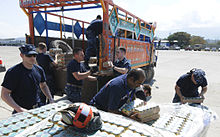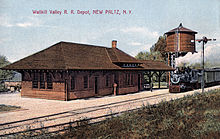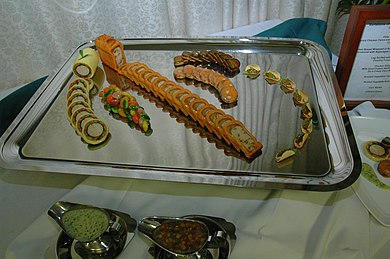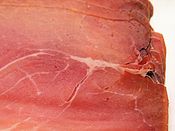Portal:Food
F o o d
A portal dedicated to food and foodways
Introduction


Food is any substance consumed by an organism for nutritional support. Food is usually of plant, animal, or fungal origin and contains essential nutrients such as carbohydrates, fats, proteins, vitamins, or minerals. The substance is ingested by an organism and assimilated by the organism's cells to provide energy, maintain life, or stimulate growth. Different species of animals have different feeding behaviours that satisfy the needs of their metabolisms and have evolved to fill a specific ecological niche within specific geographical contexts.
Omnivorous humans are highly adaptable and have adapted to obtain food in many different ecosystems. Humans generally use cooking to prepare food for consumption. The majority of the food energy required is supplied by the industrial food industry, which produces food through intensive agriculture and distributes it through complex food processing and food distribution systems. This system of conventional agriculture relies heavily on fossil fuels, which means that the food and agricultural systems are one of the major contributors to climate change, accounting for as much as 37% of total greenhouse gas emissions. (Full article...)
Cooking, also known as cookery or professionally as the culinary arts, is the art, science and craft of using heat to make food more palatable, digestible, nutritious, or safe. Cooking techniques and ingredients vary widely, from grilling food over an open fire, to using electric stoves, to baking in various types of ovens, reflecting local conditions. Cooking is an aspect of all human societies and a cultural universal.
Preparing food with heat or fire is an activity unique to humans. Archeological evidence of cooking fires from at least 300,000 years ago exists, but some estimate that humans started cooking up to 2 million years ago.
The expansion of agriculture, commerce, trade, and transportation between civilizations in different regions offered cooks many new ingredients. New inventions and technologies, such as the invention of pottery for holding and boiling of water, expanded cooking techniques. Some modern cooks apply advanced scientific techniques to food preparation to further enhance the flavor of the dish served. (Full article...)
A pasty (/ˈpæsti/) is a British baked pastry, a traditional variety of which is particularly associated with Cornwall, South West England, but has spread all over the British Isles, and elsewhere through the Cornish diaspora. It is made by placing an uncooked filling, typically meat and vegetables, in the middle of a flat shortcrust pastry circle, bringing the edges together in the middle, and crimping over the top to form a seal before baking.
The traditional Cornish pasty, which since 2011 has had Protected Geographical Indication (PGI) status in Europe, is filled with beef, sliced or diced potato, swede (also known as yellow turnip or rutabaga – referred to in Cornwall and other parts of the West Country as turnip) and onion, seasoned with salt and pepper, and baked. Today, the pasty is the food most associated with Cornwall. It is a traditional dish and accounts for 6% of the Cornish food economy. Pasties with many different fillings are made, and some shops specialise in selling pasties. (Full article...)
Selected article –
Selected cuisine -

Chinese cuisine comprises cuisines originating from China, as well as from Chinese people from other parts of the world. Because of the Chinese diaspora and historical power of the country, Chinese cuisine has profoundly influenced many other cuisines in Asia and beyond, with modifications made to cater to local palates. Chinese food staples such as rice, soy sauce, noodles, tea, chili oil, and tofu, and utensils such as chopsticks and the wok, can now be found worldwide.
The world's earliest eating establishments recognizable as restaurants in the modern sense first emerged in Song dynasty China during the 11th and 12th centuries. Street food became an integral aspect of Chinese food culture during the Tang dynasty, and the street food culture of much of Southeast Asia was established by workers imported from China during the late 19th century. (Full article...)Selected ingredient –

Stock, sometimes called bone broth, is a savory cooking liquid that forms the basis of many dishes – particularly soups, stews, and sauces. Making stock involves simmering animal bones, meat, seafood, or vegetables in water or wine, often for an extended period. Mirepoix or other aromatics may be added for more flavor. (Full article...)
Selected recipe –
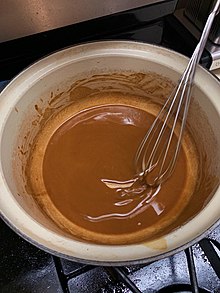
Roux (/ruː/) is a mixture of flour and fat cooked together and used to thicken sauces. Roux is typically made from equal parts of flour and fat by weight. The flour is added to the melted fat or oil on the stove top, blended until smooth, and cooked to the desired level of brownness. A roux can be white, blond (darker) or brown. Butter, bacon drippings or lard are commonly used fats. Roux is used as a thickening agent for gravy, sauces, soups and stews. It provides the base for a dish, and other ingredients are added after the roux is complete. (Full article...)
New Paltz station is a former train station in the village of New Paltz in Ulster County, New York. The building was the first of two railroad stations constructed in the town of New Paltz, and it is the only former Wallkill Valley Railroad station standing at its original location.
After a lengthy public debate over whether to place the station to the east or west of the Wallkill River, it was built in 1870 on the east bank, within the village of New Paltz. The rail line was formally opened during a large ceremony on December 20, 1870. A decade later the station had become a popular departure point for the Mohonk Mountain House by many vacationers, including two U.S. presidents. In the late 19th century, over a dozen stagecoaches ran between the station and Mohonk daily. (Full article...)Selected image –
Selected biography –
Alain Ducasse
B. September 13th 1956
Alain Ducasse (French: [alɛ̃ dykas]; born 13 September 1956) is a French-born Monégasque chef. He operates a number of restaurants including Alain Ducasse at The Dorchester which holds three stars (the top rating) in the Michelin Guide. (Full article...)
Did you know (auto-generated) –

- ... that an investigation found that most Mexican nutrition science students could not interpret a nutritional front-of-package labeling system correctly?
- ... that in Spain, it is considered lucky to eat twelve grapes while wearing red underwear received as a gift at midnight on New Year's Eve?
- ... that in 1969, the man from Del Monte said yes to Eldorado Electrodata?
- ... that the horned sungem becomes a nectar robber when food is scarce?
- ... that John Bunker was inspired to propagate old apple tree varieties after encountering Black Oxford apples while managing the food co-op in Belfast, Maine?
- ... that within the Armenian Rite, it takes 40 days and more than 40 flowers, herbs, and spices to create the chrism known as myron?
More did you know –
Related portals
Food topics
The following are topics relating to food
Categories
Food list articles
- See also: Lists of foods and Category:Lists of drinks
The following are some Food list articles on Wikipedia:

- American cheeses
- Appellation d'Origine Contrôlée cheeses
- Apple cultivars
- Bacon dishes
- Bacon substitutes
- Basil cultivars
- Breads
- Breakfast beverages
- Breakfast cereals
- Breakfast foods
- British cheeses
- Cakes
- Candies
- Cheeses
- Cheese soups
- Christmas dishes (list)
- Cocktails
- Cookies
- Dishes using coconut milk
- Diets
- Doughnut varieties
- Egg dishes
- Fermented soy products
- Food additives
- Food additives (Codex Alimentarius)
- Foods named after people
- French cheeses
- French dishes
- Fried dough foods
- Fruits
- List of hamburgers
- Herbs and spices
- Hors d'oeuvre
- Indian dishes
- Indian snack foods
- Indonesian dishes
- Italian dishes
- Japanese snacks
- Japanese dishes
- Jewish dishes
- Kebabs
- Korean beverages
- Mango cultivars
- Moroccan dishes
- Pasta
- Pastries
- Philippine snack food
- Pies, tarts and flans
- Poppy seed pastries and dishes
- Potato dishes
- Puddings
- Raw fish dishes
- Rice dishes
- Rolled foods
- Sauces
- Seafood
- Seeds
- Sandwiches
- Snack foods
- Soft drinks by country
- Soul foods and dishes
- Soups
- Stews
- Street foods
- Tapas
- Turkish dishes
- Twice-baked foods
- Vegetable oils
- Vegetables
- Vodkas
Things you can do
Related WikiProjects
| Parent project: WikiProject Food and Drink | |
| Child projects: | Task forces: (All inactive) |
|
|
| Related projects: | |
New articles
Rules | Match log | Results page (for watching) | Last updated: 2024-05-13 19:22 (UTC)
Note: The list display can now be customized by each user. See List display personalization for details.
- Koji (food) (edit | talk | history | links | watch | logs | tools) by Ghilt (talk · contribs · new pages (2)) started on 2024-05-13, score: 10
- Half and Half Doughnut Co. (edit | talk | history | links | watch | logs | tools) by Another Believer (talk · contribs · new pages (92)) started on 2024-05-13, score: 10
- Williams and Woods (edit | talk | history | links | watch | logs | tools) by GeneralBelly (talk · contribs · new pages (4)) started on 2024-05-12, score: 10
- Thamnaconus hypargyreus (edit | talk | history | links | watch | logs | tools) by Primium (talk · contribs · new pages (11)) started on 2024-05-12, score: 10
- Akbar Mirza Khaleeli (edit | talk | history | links | watch | logs | tools) by Bingchungus (talk · contribs · new pages (2)) started on 2024-05-12, score: 10
- Garry Kennebrew (edit | talk | history | links | watch | logs | tools) by AllWeKnowOfHeaven (talk · contribs · new pages (3)) started on 2024-05-06, score: 10
- Demonstration kitchen (edit | talk | history | links | watch | logs | tools) by Whoisjohngalt (talk · contribs · new pages (1)) started on 2024-05-12, score: 20
- China in Box (edit | talk | history | links | watch | logs | tools) by Vitorperrut555 (talk · contribs · new pages (1)) started on 2024-05-12, score: 20
- Chinatown Ice Cream Factory (edit | talk | history | links | watch | logs | tools) by ForsythiaJo (talk · contribs · new pages (108)) started on 2024-05-11, score: 10
- Pepsi AM (edit | talk | history | links | watch | logs | tools) by Tatsnorad (talk · contribs · new pages (2)) started on 2024-05-11, score: 20
- South Bend Chocolate Company (edit | talk | history | links | watch | logs | tools) by CusterDome (talk · contribs · new pages (1)) started on 2024-05-11, score: 10
- Hey Chicken! (edit | talk | history | links | watch | logs | tools) by Luvcraft (talk · contribs · new pages (1)) started on 2024-05-11, score: 10
- Ko Omm (edit | talk | history | links | watch | logs | tools) by Sattwaikyaw (talk · contribs · new pages (1)) started on 2024-05-11, score: 10
- Soumaintrain (cheese) (edit | talk | history | links | watch | logs | tools) by WillBanz (talk · contribs · new pages (1)) started on 2024-05-11, score: 20
- SugarBun (edit | talk | history | links | watch | logs | tools) by The Bangsawan (talk · contribs · new pages (3)) started on 2024-05-11, score: 10
- List of whisky brands in England (edit | talk | history | links | watch | logs | tools) by ChefBear01 (talk · contribs · new pages (4)) started on 2024-05-10, score: 20
- Donut Factory (edit | talk | history | links | watch | logs | tools) by Another Believer (talk · contribs · new pages (92)) started on 2024-05-10, score: 10
- Causa (restaurant) (edit | talk | history | links | watch | logs | tools) by Another Believer (talk · contribs · new pages (92)) started on 2024-05-10, score: 10
- Rania (restaurant) (edit | talk | history | links | watch | logs | tools) by Another Believer (talk · contribs · new pages (92)) started on 2024-05-10, score: 10
- Adams Oyster Company (edit | talk | history | links | watch | logs | tools) by DMVHistorian (talk · contribs · new pages (12)) started on 2024-05-10, score: 10
- Spaghetti alla siracusana (edit | talk | history | links | watch | logs | tools) by JackkBrown (talk · contribs · new pages (2)) started on 2024-05-09, score: 10
- Puffed rice cakes (edit | talk | history | links | watch | logs | tools) by 2003:CA:8718:D68F:4AEE:DFFA:5B34:E259 (talk · contribs · new pages (1)) started on 2024-05-09, score: 30
- Osmotherium (edit | talk | history | links | watch | logs | tools) by LaraPoasting (talk · contribs · new pages (4)) started on 2024-05-09, score: 10
- Fresh Thyme (edit | talk | history | links | watch | logs | tools) by 96.69.249.93 (talk · contribs · new pages (2)) started on 2024-05-09, score: 10
- Chicago Steak Company (edit | talk | history | links | watch | logs | tools) by AbrilTheCarpenter (talk · contribs · new pages (1)) started on 2024-05-09, score: 20
- Berry chantilly cake (edit | talk | history | links | watch | logs | tools) by BaduFerreira (talk · contribs · new pages (9)) started on 2024-05-01, score: 10
- Jason Fuller (edit | talk | history | links | watch | logs | tools) by The Bicycle of Dreams (talk · contribs · new pages (1)) started on 2024-05-08, score: 10
- Nikolay Vereshchagin (edit | talk | history | links | watch | logs | tools) by Kolya Muratov (talk · contribs · new pages (2)) started on 2024-05-07, score: 10
- Cardinal slice (edit | talk | history | links | watch | logs | tools) by Pek (talk · contribs · new pages (19)) started on 2024-05-07, score: 10
- Big Potato Man (edit | talk | history | links | watch | logs | tools) by B3251 (talk · contribs · new pages (34)) started on 2024-05-06, score: 10
- 2024–25 West Ham United F.C. season (edit | talk | history | links | watch | logs | tools) by Egghead06 (talk · contribs · new pages (4)) started on 2024-05-06, score: 10
- Tarte à l'badrée (edit | talk | history | links | watch | logs | tools) by Frankserafini87 (talk · contribs · new pages (3)) started on 2024-05-06, score: 20
- Café Avole (edit | talk | history | links | watch | logs | tools) by Another Believer (talk · contribs · new pages (92)) started on 2024-05-05, score: 10
- Subric (edit | talk | history | links | watch | logs | tools) by Frankserafini87 (talk · contribs · new pages (3)) started on 2024-05-05, score: 10
- Association of Estonian Food Industry (edit | talk | history | links | watch | logs | tools) by Estopedist1 (talk · contribs · new pages (5)) started on 2024-05-05, score: 20
- Ghost Note Coffee (edit | talk | history | links | watch | logs | tools) by Another Believer (talk · contribs · new pages (92)) started on 2024-05-05, score: 10
- Integrated Aqua-Vegeculture System (edit | talk | history | links | watch | logs | tools) by Wiki142B (talk · contribs · new pages (1)) started on 2024-05-05, score: 10
- Bark City BBQ (edit | talk | history | links | watch | logs | tools) by Another Believer (talk · contribs · new pages (92)) started on 2024-05-04, score: 10
- Fava (Greek dish) (edit | talk | history | links | watch | logs | tools) by Lambiam (talk · contribs · new pages (7)) started on 2024-05-04, score: 20
- Mian Nadeem Riaz (edit | talk | history | links | watch | logs | tools) by HRShami (talk · contribs · new pages (11)) started on 2024-05-03, score: 10
- Šumienkový zákusok (edit | talk | history | links | watch | logs | tools) by Aaa000000 (talk · contribs · new pages (4)) started on 2024-05-03, score: 20
- Pudingový koláč (edit | talk | history | links | watch | logs | tools) by Aaa000000 (talk · contribs · new pages (4)) started on 2024-05-03, score: 20
- Michelle Yoo (edit | talk | history | links | watch | logs | tools) by DrThneed (talk · contribs · new pages (19)) started on 2024-05-02, score: 10
- 2009 Peanut Corporation of America recall (edit | talk | history | links | watch | logs | tools) by Isochrone (talk · contribs · new pages (2)) started on 2024-05-02, score: 10
- Biscuit warmer (edit | talk | history | links | watch | logs | tools) by Wallclockticking (talk · contribs · new pages (5)) started on 2024-05-02, score: 10
- Meat jobber (edit | talk | history | links | watch | logs | tools) by GobsPint (talk · contribs · new pages (44)) started on 2024-05-02, score: 10
- Genevoise sauce (edit | talk | history | links | watch | logs | tools) by Frankserafini87 (talk · contribs · new pages (3)) started on 2024-05-02, score: 10
- Meat broker (edit | talk | history | links | watch | logs | tools) by GobsPint (talk · contribs · new pages (44)) started on 2024-05-02, score: 10
- Kolkata biryani (edit | talk | history | links | watch | logs | tools) by খাঁ শুভেন্দু (talk · contribs · new pages (3)) started on 2024-05-02, score: 10
- Branch house (building) (edit | talk | history | links | watch | logs | tools) by GobsPint (talk · contribs · new pages (44)) started on 2024-05-02, score: 20
- Walnut cake with egg yolk glaze (edit | talk | history | links | watch | logs | tools) by Aaa000000 (talk · contribs · new pages (4)) started on 2024-05-01, score: 20
- Tac/Quila (edit | talk | history | links | watch | logs | tools) by Another Believer (talk · contribs · new pages (92)) started on 2024-05-01, score: 10
- Underage club (edit | talk | history | links | watch | logs | tools) by Wallclockticking (talk · contribs · new pages (5)) started on 2024-05-01, score: 10
- Museum of Toruń Gingerbread (edit | talk | history | links | watch | logs | tools) by Dnaoro (talk · contribs · new pages (3)) started on 2024-05-01, score: 20
- Murau Brewery (edit | talk | history | links | watch | logs | tools) by 0Lucky Luke (talk · contribs · new pages (1)) started on 2024-05-01, score: 10
- Esther Choi (edit | talk | history | links | watch | logs | tools) by MemeDab99 (talk · contribs · new pages (3)) started on 2024-04-30, score: 10
- Greens powder (edit | talk | history | links | watch | logs | tools) by Psywave (talk · contribs · new pages (1)) started on 2024-04-30, score: 10
- Koffi (restaurant) (edit | talk | history | links | watch | logs | tools) by Another Believer (talk · contribs · new pages (92)) started on 2024-04-30, score: 10
- H. Avard Loomer (edit | talk | history | links | watch | logs | tools) by B3251 (talk · contribs · new pages (34)) started on 2024-04-30, score: 10
- Sherman's Deli & Bakery (edit | talk | history | links | watch | logs | tools) by Another Believer (talk · contribs · new pages (92)) started on 2024-04-30, score: 10
- Paul B. Wishart (edit | talk | history | links | watch | logs | tools) by Dmarsch (talk · contribs · new pages (2)) started on 2024-04-29, score: 10
- Meat water holding capacity (edit | talk | history | links | watch | logs | tools) by GobsPint (talk · contribs · new pages (44)) started on 2024-04-29, score: 10
- Meat diaper (edit | talk | history | links | watch | logs | tools) by GobsPint (talk · contribs · new pages (44)) started on 2024-04-29, score: 20
- Localis (restaurant) (edit | talk | history | links | watch | logs | tools) by Another Believer (talk · contribs · new pages (92)) started on 2024-04-29, score: 10
- Kōki Saitō (edit | talk | history | links | watch | logs | tools) by Cynikles (talk · contribs · new pages (1)) started on 2024-04-29, score: 10
- 24 in 24: Last Chef Standing (edit | talk | history | links | watch | logs | tools) by TristanQuinn (talk · contribs · new pages (1)) started on 2024-04-29, score: 10
- La Mejor Bakery (edit | talk | history | links | watch | logs | tools) by BaduFerreira (talk · contribs · new pages (9)) started on 2024-04-29, score: 20
Associated Wikimedia
The following Wikimedia Foundation sister projects provide more on this subject:
-
Commons
Free media repository -
Wikibooks
Free textbooks and manuals -
Wikidata
Free knowledge base -
Wikinews
Free-content news -
Wikiquote
Collection of quotations -
Wikisource
Free-content library -
Wikiversity
Free learning tools -
Wiktionary
Dictionary and thesaurus























